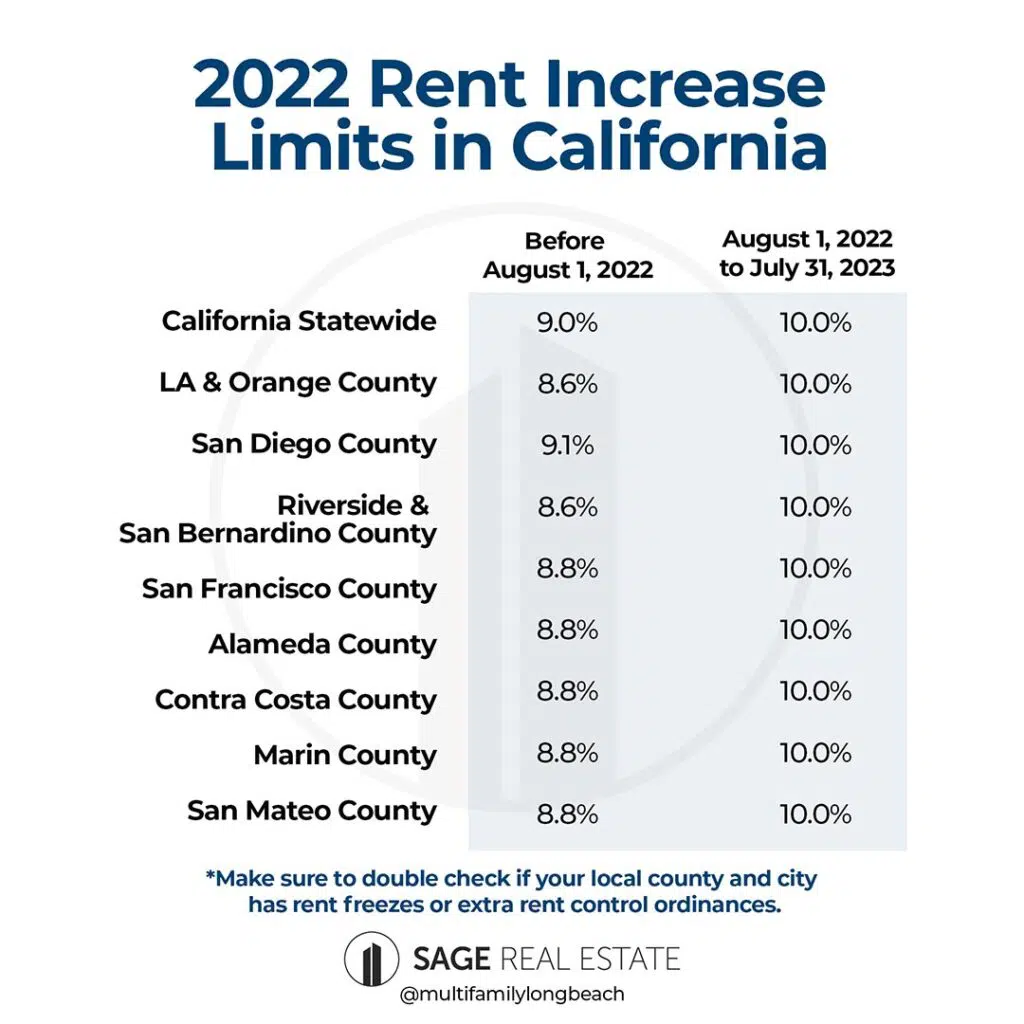Rents nationwide are skyrocketing to insane levels, and in some areas, they’ve gone up more than 30% percent. The record-high inflation that we’re experiencing has also brought the cost of living in California through the roof. But what about rents in California? How much can a landlord legally raise the rent in California? Although it’s a common question for landlords and tenants alike, there isn’t a straightforward answer that works for everyone. The short answer is that it depends on your property and location in California. In this article, we’ll be covering everything you need to know so you can figure out the specific answer for you!
California is home to over 40 million people, and half of its population are renters. As a result of rising rent prices that have been continuously increasing for the last two decades, California has also turned into one of the most expensive places to live in the United States. An ongoing housing crisis that can’t meet housing demand and dwindling middle-class jobs have forced the State of California to pass a series of rent control laws with AB-1482 to help maintain affordable housing for low-income and moderate-income households. Unlike in many other states, California’s rent control laws and tenant protection laws passed during the COVID-19 pandemic have mostly prevented skyrocketing rental prices and mass evictions.
What is the minimum a landlord in California can raise the rent?
One of the main reasons a property owner may consider raising the rent prices annually is to keep up with inflation. Inflation basically reflects the annual percentage change in the cost of consumer goods and services, and it is typically measured by the U.S. Bureau of Labor Statistics as the Consumer Price Index. Before 2021, the rate of inflation in the United States typically varies between 1% to about 4%.
In 2022, many renters and landlords like yourself are worried because the rate of inflation in the United States has risen to record-high levels that we haven’t seen since 1980. Last month in March 2022, the rate of inflation was as high as 8.5%.
According to the Tenant Protection Act of 2019, also known as AB 1482, landlords are allowed annual rent increases of 5% plus the percentage change in the cost of living (Consumer Price Index) per year, up to 10%.
Technically, there is no minimum amount landlords can raise the rent. Landlords are not legally required to raise the rent every year so a landlord in California may raise the rent by 0% or as low as 0.1%.
However, there are exemptions to this rent control law. Certain properties are exempt from AB 1482, and landlords have the right to raise the rent however much they please.
Which properties are exempt from rent control?
These properties are exempt from the Tenant Protection Act of 2019:
- Single-family homes and condominiums as long as they are NOT owned by a corporation, a REIT (real estate investment trust), or an LLC where one member is a corporation.
- Any duplex where the owner lives in the other unit
- Mobile homes
- School and college dormitories
- Hotels
- Commercial properties (retail stores, restaurants, etc.)
- Buildings built within the last 15 years (including accessory dwelling units)
- Rental properties provided by non-profit organizations
- Rental properties subject to pre-existing local ordinances
If a rental property falls under any of these situations, the landlord must provide a notice of exemption from AB 1482 to their tenants. Landlords with properties that are not subject to rent control laws can increase their rents as much as necessary.
However, we still urge both landlords and tenants to double-check with their local city laws as some cities, which have had rent control laws in place before AB 1482, have special restrictions.
What is the maximum a landlord in California can raise the rent?
The answer to this question is sort of complicated because it depends on the city and county you’re located in. As stated in AB1482, every rental property in California (that is not exempt from rent control) can have an annual rent increase of 5% plus the percentage change in the cost of living (Consumer Price Index) per year.
The CPI is a measure, published by the US Bureau of Labor Statistics, of the average change over time in the prices paid by urban consumers for a market basket of consumer goods and services, which is basically a measure of inflation in the economy.
The lawmakers of AB 1482 decided that the CPI percentage change should be based from April 1st of the prior year to April 1st of the current year for the region where the property is located.
What this means is that:
- there are different CPI indexes available for different cities and regions in the United States,
- and in order to calculate the maximum amount landlords can increase rent in your area (5% plus CPI),
- you must use the April CPI for your metropolitan region in California.
If you want to learn how to calculate your region’s CPI, you can read our detailed step-by-step guide here.
According to the Bureau of Labor Statistics in 2022, the nationwide CPI went up to 8.5% in March and 8.3% in April. Here are the CPI numbers for California and its four major areas:
- For the Los Angeles-Long Beach-Anaheim Area, the April 2022 CPI is 7.9%. This area includes Los Angeles County and Orange County.
- For the San Francisco-Oakland-Hayward Area, the 2022 CPI is 5.0%. This area includes Alameda County, Contra Costa County, Marin County, San Francisco County, and San Mateo County.
- For the Riverside-San Bernardino-Ontario Area, the CPI rose to 10% in March 2022. This area includes Riverside County and San Bernardino County.
- For the San Diego-Carlsbad Area, the CPI rose to 7.9% in March 2022. This area includes all of San Diego County.
- For any county or city that isn’t included in the four main areas, you’ll need to use the California State CPI which rose up to 7.4% in 2022 according to the California Department of Industrial Relations.
When you add your region’s CPI to the minimum allowable rent increase of 5% using 2022 CPI numbers, you may end up with a two-digit number. For example, if you live in Long Beach, which is Los Angeles County, you may have a number of 12.9%. However, that is not the maximum a landlord can raise the rent in Long Beach.
That’s because California’s AB-1482 rent control law caps the maximum allowable annual rent increase to only 10%. So in most cities and situations, California landlords who are not exempt from rent control can only raise the rent by a minimum of 5% and a maximum of 10% starting August 1, 2022 until July 31, 2023.
Before August 1, 2022, landlords must use the rental increase limits using the CPI numbers from April 2021, which we’ve provided in the image below.
Please also be aware that there may be rent freezes due to COVID-19 in your city. For example, there is currently a rent freeze in effect for the city of Los Angeles (not Los Angeles County) until May 2023.

Important Note: This calculation of (5% + April CPI) applies to most situations. However certain cities in California, which have had rent control in place before 2020, may have slightly different rent control laws. So we’re also going to show you a step-by-step process on how to figure out the rent control laws in your city or county.
How to Figure Out the Specific Rent Control Laws in Your City or County
The statewide rent control law AB-1482 is really the least strict law that covers the entire state and is the minimum standard. However, many cities and counties within California have already had long-existing rent control ordinances that may be stricter than the state rent control law. There are also many California cities and counties that have decided that the state law isn’t strict enough. Therefore your city or county may be one of these areas in California with stricter rent control ordinances that overpower the state’s own rent control law.
Because of this, it is very important for you to know the specific rent control laws in your city or county. Whether you’re a landlord or tenant, knowing the specific rent control laws will help you learn whether they apply to you or not, and can help you avoid legal troubles.
Here’s the 5-Step-Process:
- Check to see if your county or city has an active rent freeze due to COVID-19.
- Check whether your county or city has extra rent control ordinances. Here’s a helpful article that covers all California cities with extra ordinances.
- Read the ordinance summary carefully so you’re aware of the legalities.
- Determine the CPI for your region. Read this article on how to find the CPI for your area.
- Contact your city or county’s housing department to confirm your information. This chart contains contact information that you’ll need.
What other resources could I use to determine how much landlords can legally raise the rent in California?
The next best resource for tenants or landlords curious about rent increase limits would be local apartment associations. Below is a list of some major apartment associations in California that you can reach out to:







